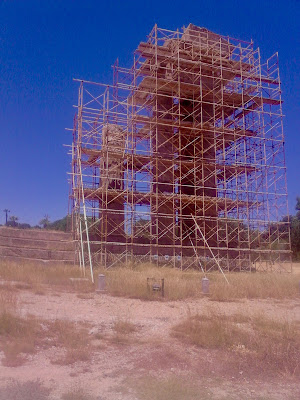On my excursion to town yesterday I decided to make the walk from the Top Three up to the Rhodes Acropolis, formerly known as 'Monte Smith', just to see how long it would take. Occasionally I get guests who want to walk it themselves and they always ask me how long it would take them to get up there and, formerly, I'd hazard a guess. It was about time I could tell them from personal experience.
Since we usually arrive in Rhodes Town at around 10.00am and we don't leave until 3.30pm, I knew that I had plenty of time, since I don't usually go into the Old Town for a spot of lunch until somewhere approaching 1.00pm. After a second one of Maria's delicious frappés [OK, if you're Greek, I know it's really 'φραπέδες' !!], I up and set out to walk it at a measured pace.
It wouldn't do much good describing the route I took from the heart of town, right next to the bus station, up to the 2,300 year-old Temple of Apollo, but I will say that it's easy to navigate. If you're not too familiar with the layout of Rhodes Town, a map in your hand will soon have you stepping it out with confidence. I actually made it in 20 minutes, so it's really not that far then is it?
Annoyingly though, I forgot the iPad (left it charging [not for drinks] at the bar) and didn't have my digital camera either, so these rather substandard photos were taken with my ageing phone!! But hopefully they'll still demonstrate why it's worth seeing the Rhodes Acropolis:
 |
| Takes a bit of squinting, but the tiers of the athletic stadium can be seen through the trees. It will help to click on the photo to get the larger view. |
 |
| Just a tad closer, making the tiers more visible. |
 |
| Just a slight adjustment on the view above. |
 |
| Sadly the remaining columns of the Temple of Apollo are currently shrouded in scaffolding. Let's face it, there's never a good time to do a spot of shoring up when it takes a year or two, is there. |
Regarding the work being done on preserving the temple's remaining four and a half columns before even they too crumble and tumble to the ground, I was interested in the rather large sign that greeted me as I entered the park. It was one of those European Union signs that details the archaeological work being carried out and stating the amount of EU cash that's being pumped into the project. It was €1.6 million. Couldn't help thinking about all those road, social and cultural projects in the UK that will in all possibility soon not be able to benefit from such financial aid. Maybe I'm over-simplifying things. I dunno.
 |
| I really do love this view down across the town from the terrace just below the temple, with the mountains of Southern Turkey (Asia Minor) on the horizon. |
 |
| The view you get of the stadium from the road that cuts down through the park. |
 |
| I caught a glimpse of this while passing. Is that a magnificent bougainvillea or what? |
•
Just changing the subject a little. On our way home I ended up talking with Nikos, who drives the coach, about the snakes on the island, since he'd seen a large black one basking on the road earlier in the day. Now, in chapter 11 of 'A Jay in the Jacaranda Tree' I talk a bit about the snakes and how the deer were originally introduced to the island to keep the snake population down. There are many theories about how the deer are supposed to do this and, if I'm honest, I find all of them a little hard to make any sense out of. Nikos, however, came out with the answer that does tick all the boxes and makes ultimate sense.
Rather than hopefully trampling snakes under foot (I mean, why would a snake hang about to be trampled on anyway?), or their dung being a snake deterrent, Nikos' explanation was that the deer trample on the snakes' nests and thus destroy their eggs. It could be that the deer even forage and eat the eggs as a delicacy. Either way, that explanation seems much more feasible to me and would indeed result in a lowering of the snake-breeding success rate, thus controlling their numbers effectively. Snakes nest in shallow depressions in the ground, thus leaving the unhatched eggs at the mercy of deer hooves or gnashers.
Seems to me that's another problem solved! Right, now I'm off to tackle third world debt...



No comments:
Post a Comment